Scotland’s Rail Services Decarbonisation Action Plan details how rail passenger services will be decarbonised by 2035. By then, the aim is for all core routes to be electrified with services on the remaining less-intensively used routes powered by either battery or hydrogen powered traction.
For some, Hydrogen trains are an unnecessary distraction. They are considered to be inefficient and more expensive to operate than battery trains and require complex novel fuelling arrangements.
Such views, however, do not take account of the need to develop a hydrogen economy which will be required if the necessary transition from fossil fuels is to be achieved. In issue 193 (Nov-Dec 2021), Rail Engineer reported on the COP26 hydrogen transition summit. This explained why hydrogen is essential for a low carbon economy as it is the only way to decarbonise things that cannot be directly electrified such as ships, steel production, and heavy mobility. In addition, it can provide grid balancing for renewable power.
The Scottish Government’s Hydrogen Action Plan aims to produce 800,000 tonnes of hydrogen per annum by 2030. This equates to 27 TWh or 17% of Scotland current energy demand. The plan considers that, by 2045, a strong hydrogen sector in Scotland could support up to 300,000 jobs, many of which could use the skills of those displaced from the oil and gas industries. As part of this plan, £100 million has been committed to develop the hydrogen economy over the next five years.
The Hydrogen Accelerator (HA) at the University of St Andrews was formed to support the delivery of hydrogen technology innovations through collaboration between relevant Scottish institutions. It also aims to develop expertise to support transport applications, one of which is Scotland’s Hydrogen train. Hence, in partnership with Transport Scotland and Scottish Enterprise, HA is responsible for the project to convert a surplus ScotRail Class 314 unit into a hydrogen train demonstrator.
HA’s director, Gerry Agnew, believes the hydrogen train project will provide the understanding and knowledge to make hydrogen-powered rail a reality in the not-too-distant future. He also advised Rail Engineer that he considered hydrogen could be produced by the surplus output from Scotland’s wind generation capacity that the national grid is unable to accept.
More than a train
The above provides the context for the Scotland’s Hydrogen train and explains why this project is about much more than a train. This is also shown by the project’s objectives which are:
- Proving that Scotland can modify rolling stock to install a hydrogen drive train.
- Working with the regulatory bodies to develop the necessary standards for the use of hydrogen powered passenger rolling stock.
- Informing rail policy on the application of hydrogen train technology on the Scottish rail network.
- Demonstrating to Scotland’s rail community, the practical application of hydrogen fuel cell electric passenger rolling stock.
- Providing Scotland’s supply chain with the opportunity to develop its skills and knowledge to apply to hydrogen fuel cell electric technologies on passenger rolling stock and understand the issues relating to hydrogen supply and refuelling infrastructure.
- Providing educational institutions with the opportunity to research the practical application of hydrogen fuel cell electric technologies within the rail industry.
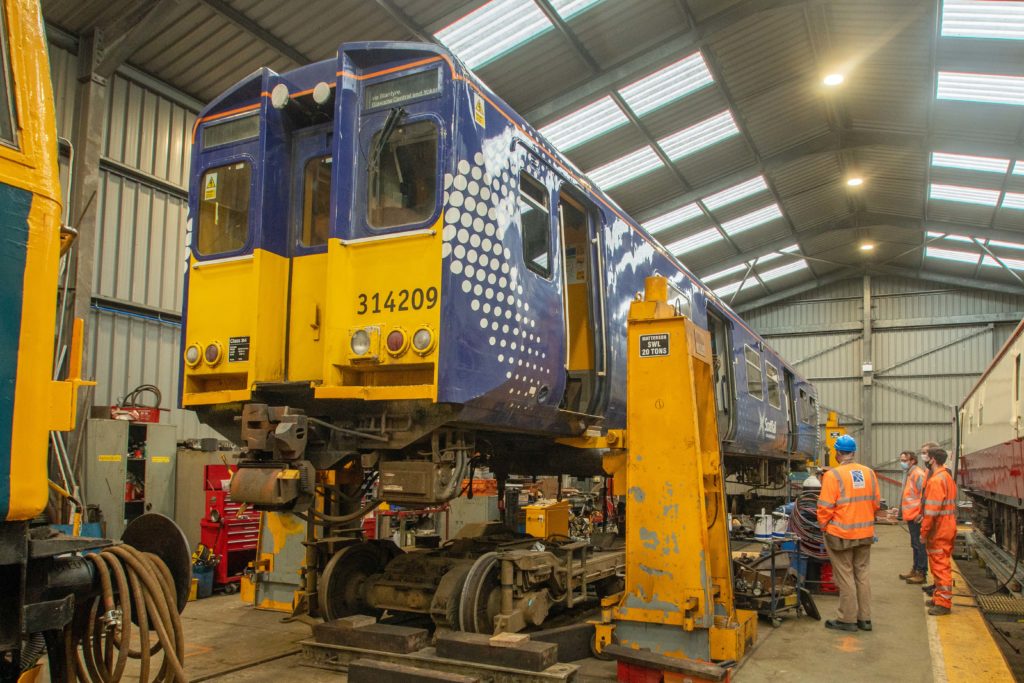
As described in issue 188 (Jan-Feb 2021), HA let the £2.7 million contract for this project in December 2020 to an industry consortium led by Arcola Energy working with partners Arup, Abbott Risk Consulting, and Aegis. Arcola Energy was subsequently taken over by Ballard Power Systems in November 2021 to become Ballard Motive Solutions. Following the contract award, the surplus Class 314 unit was immediately moved from Yoker Depot to the Bo’ness and Kinneil heritage railway for its conversion at the railway’s Bo’ness workshops.
As well as the work at Bo’ness, the fuel cell, battery, and hydrogen storage rafts were assembled and tested at the Michelin Scotland Innovation Parc (MSIP) in Dundee. MSIP is to be a skills and innovation hub for industry and academia to collaborate on sustainable mobility, clean transport, and low-carbon energy. It is the site of a tyre factory which closed in 2018. A year later, a £60 million package, funded by Michelin, Scottish Enterprise, and Dundee City Council, to develop MSIP was announced. In 2021, further funding was allocated to create LOCATE (Low Carbon Transport Applications Centre) at MSIP. This will support the development and testing of heavy-duty vehicle hydrogen and battery electric powertrains.
Arcola was one of the first companies to move into MSIP. AMTE Power, one of the only companies in the UK to manufacture battery cells, also recently selected MSIP as its preferred site for a new factory as part of its strategy to rapidly scale up production.
During COP26, an exhibition at Bo’ness was attended by 398 visitors. This featured the components that were to be installed on the train together with the refuelling plant as well as a bin lorry and construction lighting tower that were both powered by hydrogen.
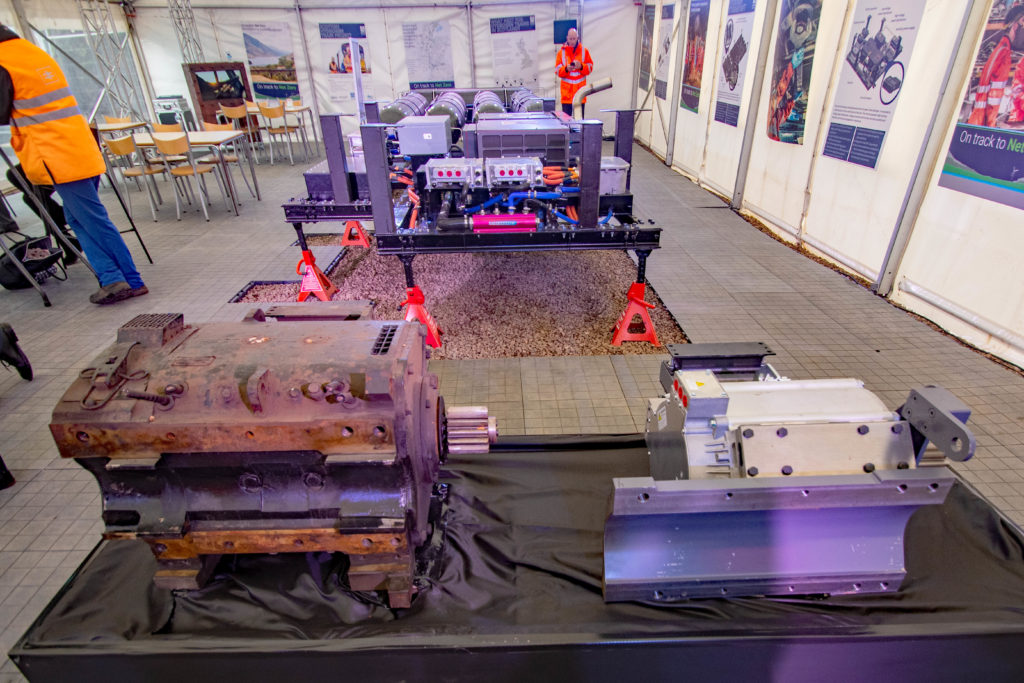
After delays due to Covid and material shortages, testing of the train started in mid-August. Shortly afterwards a ‘Future Vision Workshop’ was held at Bo’ness to demonstrate the train’s technology and its hydrogen refuelling facility. This involved key stakeholders and considered how hydrogen trains can help accelerate Scotland’s hydrogen economy and create opportunities in supply chain, innovation, high value jobs, and skills development.
314 into 614
The 3-car Class 314 EMU consists of two Driving Motor Standard Open (DMSO) cars at each end of the unit and a Pantograph Trailer Second Open (PTSO) car in the middle. The conversion involved the removal of all the traction equipment, including the traction motor but excluding the pantograph. All items removed and the new equipment fitted were weighed to confirm that there was no significant difference in weight between the original and the converted unit.
The table shows additional equipment added and original equipment retained for each vehicle.
Following the conversion, unit 314209 became 614209 as the Class 6xx designation is for units with alternative traction.
Details of the main components are as follows:
- Fuel Cell Raft – each has a 70kW Ballard FCmove fuel cell designed to meet EMC requirements. It has a cooling system which uses the fuel cell waste heat to heat passenger compartments.
- Hydrogen tank raft – each stores 40kg of hydrogen at 350 bar in six cylinders formed of an aluminium liner with carbon-fibre wrap. The tanks can be refuelled in 20 minutes and have leak detection sensors.
- Battery raft – each has 4 x 16kWh Lithium Titanate batteries.
- High voltage power distribution unit (HVPDU) – this supplies DC current to an inverter which feeds the AC traction motors. The HVPDU manages the current flow from the fuel cell and battery as well as the current from the fuel cell to charge the battery. It does so in a manner that maximises efficiency and performance and can provide 350kW peak power.
- Traction Motor – the Dana TM4 motor is a permanent magnet 3-phase AC motor which is manufactured at scale for automotive industry resulting in lower costs. It has a continuous and maximum power of 176kW and 215kW.
Dr Ben Todd, CEO of Ballard Motive Solutions, considers that delivering a converted hydrogen-powered train in a live rail environment is “a best-practice example of government, academia, and industry working together to take an ecosystem view of the benefits of carbon-neutral technology.”
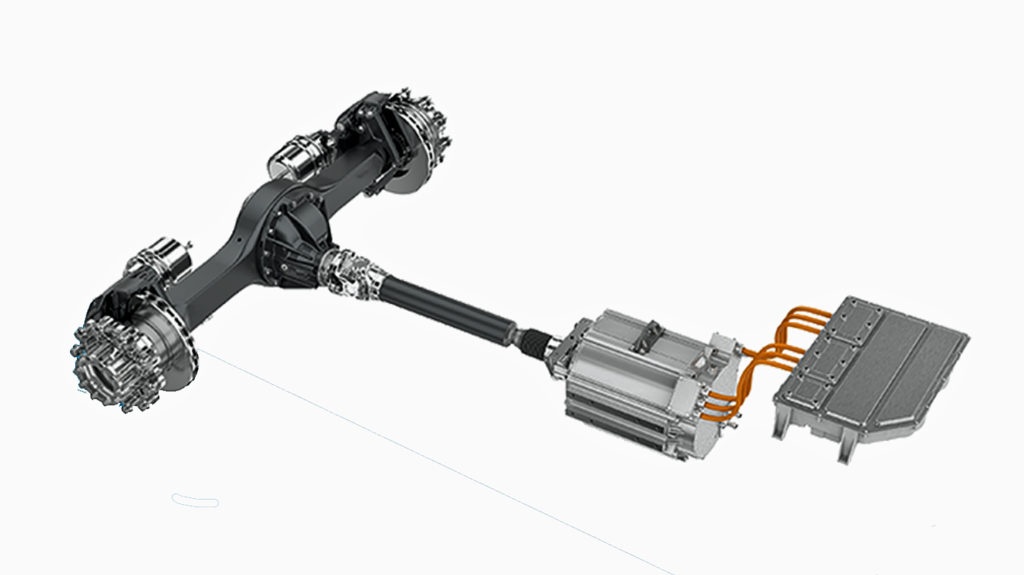
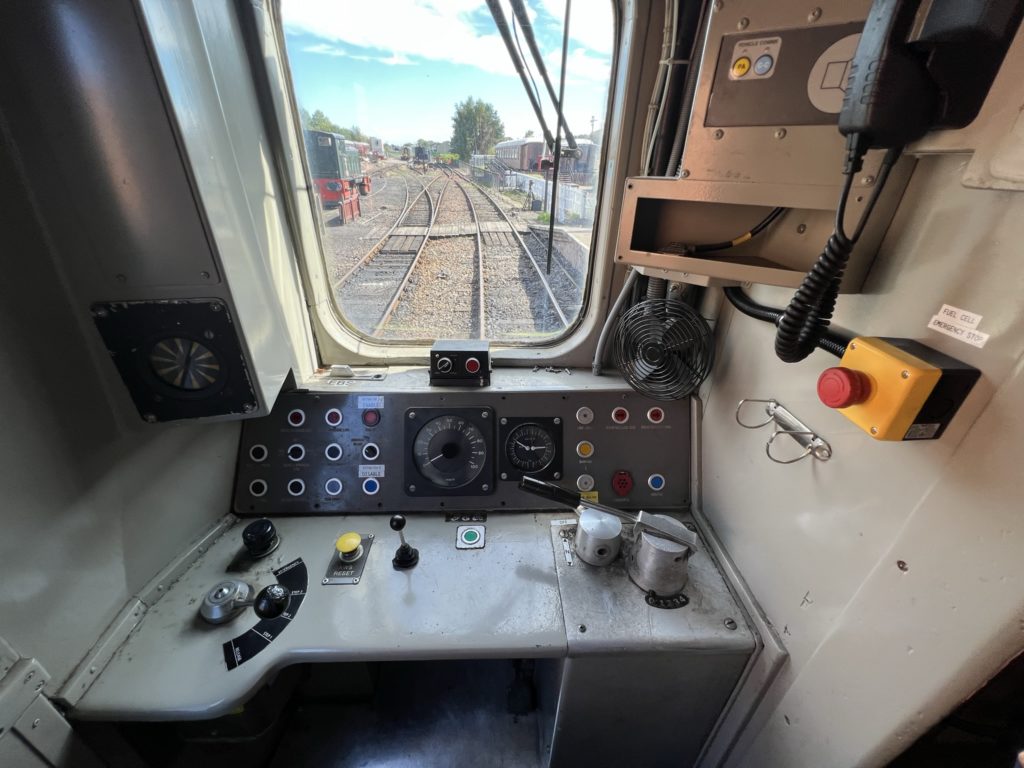

Safety and Certification
The arrangement of the power train components keeps them away from the passenger saloon and does not require a hydrogen connection between vehicles. Hydrogen storage is also separated from potential ignition sources. Yet, the underframe mounted components pose a certification challenge in respect of derailments and objects on the track.
There are risks with storing large amounts of energy on a train be it in a diesel tank, battery, or hydrogen tank. In this respect, hydrogen is arguably safer than diesel which can be atomised in a crash. Being lighter than air, hydrogen rapidly disperses in the event of a leak. This also makes it safer for those on site immediately after an incident. However, a hydrogen / air mixture can be explosive in confined spaces such as tunnels for which special precautions are required, such as avoiding venting.
Scotland’s Class 614 Hydrogen train will not be certified for main line operation as there are significant certification costs for just one train and much can be learnt from its operation on the steeply graded Bo’ness and Kinneil Railway. Nevertheless, the train had to have an independently validated safety case before it was allowed to run on this railway.
One aspect that is being considered is the extent to which open standards in other sectors can be used to certify rail vehicles for operation. In the automotive sector, vendors produce components to such open standards for safety critical applications such as brakes and steering. This approach offers benefits beyond hydrogen trains, as it would allow new technology from other sectors to be used at lower cost.
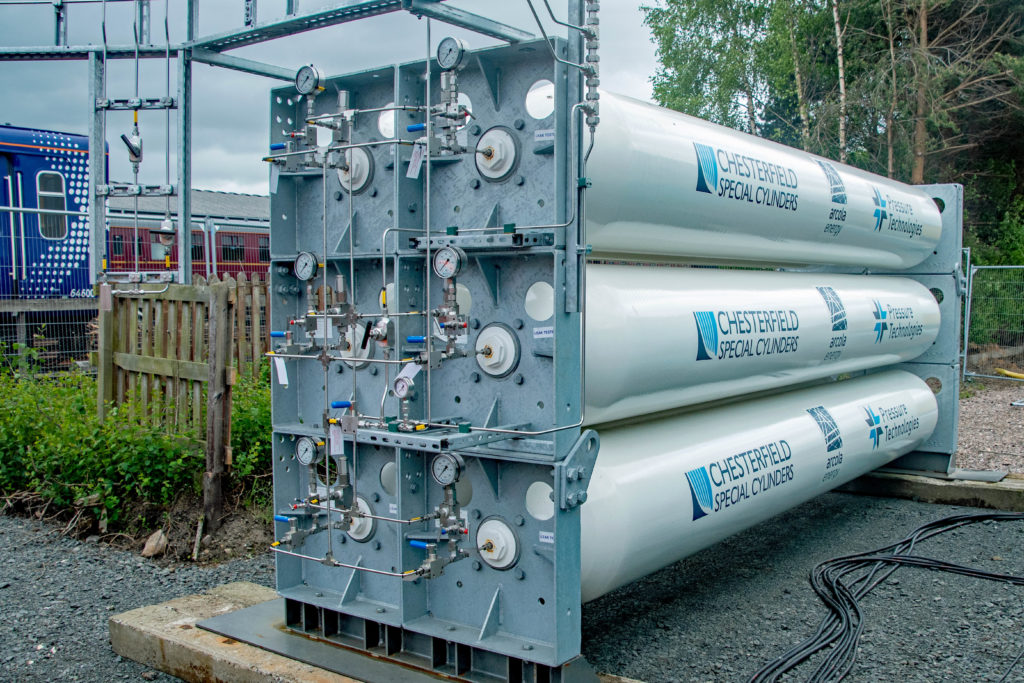
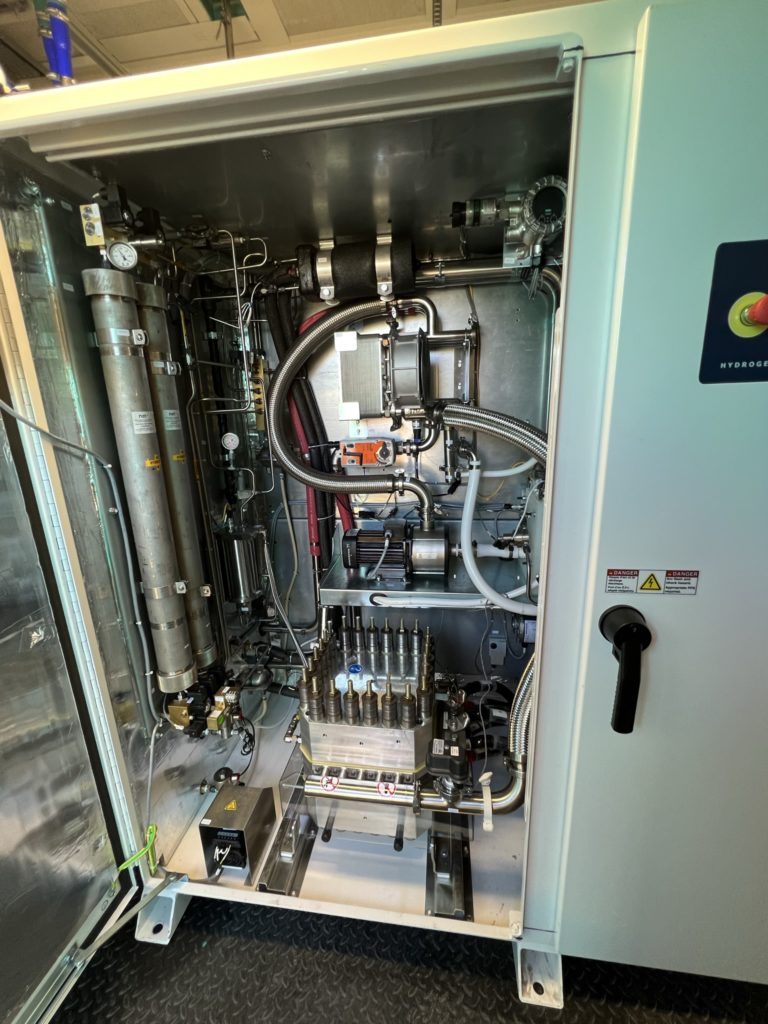
Hydrogen refuelling station
To consider the practicalities of producing hydrogen and fuelling hydrogen trains, a refuelling station has been installed at Bo’ness. This was funded by Angel trains which announced its support for the Scottish hydrogen train consortium in May 2021. It has a 70-kW electrolyser which can produce one kilogramme of vehicle-grade hydrogen per hour at 30 bar. A booster compressor powered by compressed air then compresses the hydrogen to 500 bar for storage in six stainless steel tanks supplied by Chesterfield Special Cylinders. These tanks store a total of 210 kilogrammes of hydrogen. The applicable regulations require an eight-metre exclusion zone within which there can be no sources of ignition (e.g., portable electrical equipment).
As refuelling is only possible if the storage cylinder’s pressure exceeds the pressure in the train’s hydrogen tanks, the storage tanks cannot be fully emptied. Once the pressure in the cylinder has dropped to just above 350 bar, the train is then fuelled from another cylinder. The 35kg of hydrogen in a single cylinder compares with 40kg in a single storage raft.
In this way the train can be fuelled with hydrogen in 20 minutes. The dispenser panel has two hoses, one for fuelling the vehicle and one for emptying the train’s hydrogen tank as required.
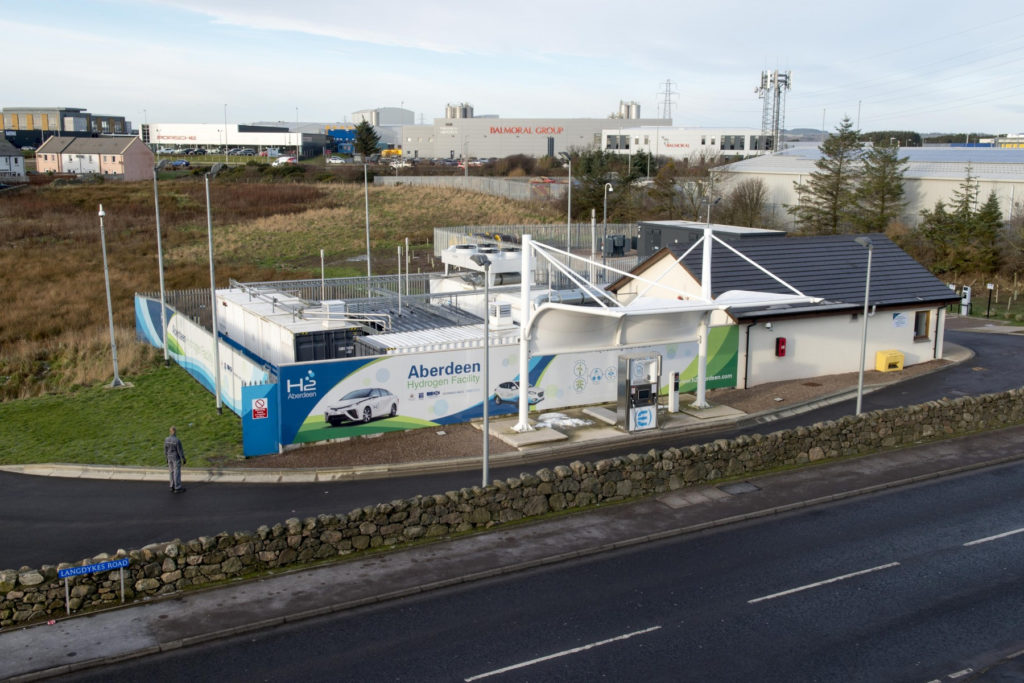
Currently 97% of Scotland’s gross electricity consumption is from renewables. Hence it would seem that Scotland’s hydrogen train is the first in the UK to be powered by green hydrogen.
Lessons to be learnt
As well as supporting the development of a hydrogen economy, experience from the Scottish hydrogen train will inform the acquisition, certification, and operation of future hydrogen trains. This supports decisions on whether to purchase new or modify existing trains, how to modify existing trains, technology transfer from other sectors, use of open standards, how depots should be supplied with hydrogen, and the future deployment strategy.
The project has also shown that the Scottish supply chain has the capability to convert an existing train into a hydrogen train. However, it has highlighted significant issues. For example, older trains may not have sufficient life to justify new investment and don’t meet modern standards for crashworthiness and persons of reduced mobility. Although older trains have simpler interfaces, their hardware is less compatible with new equipment. Newer trains have more compatible hardware, yet their complex proprietary interfaces involve huge costs without support from the original manufacturer.
Despite these problems, the use of existing trains saves the embodied carbon of making a new train and may be more feasible for low production runs. From the work done on the hydrogen train project, it is estimated that the procurement of a new build would be prohibitive for a production run of less than 20, unless this was part of an existing build.
For converted EMUs and DMUs, cost becomes prohibitive at respectively less than five and ten trains. EMUs have lower cost conversions if their motors can be retained. DMU conversions require a new expensive motor coupled to the drive shaft and have space constraints which could prove expensive.
If units are to be converted, options for hydrogen storage are below solebar if there is space, and within the car body separated from passengers which limits passenger space and restricts movement through the train. For converted trains, roof storage is not possible within the UK gauge. However, this may be possible with the flexibility of a new-build as shown at COP26, when Alstom announced a new UK hydrogen train concept using their Aventra platform with roof-mounted hydrogen tanks.
Converted trains offer no benefit as far as safety certification is concerned as almost everything gets modified so little can be grandfathered from old designs. The challenge of certifying hydrogen trains is that, for rail, this is a new technology, although in other sectors, its safe production, transport, and storage is well understood. As previously mentioned, if the use of open standards can be accepted, technology transfer from other sectors could be accelerated. Indeed, the hydrogen drive train in the Class 314, including the permanent magnet AC motor, is the A-drive developed by Arcola which is being used on Glasgow’s hydrogen bin lorries.
The strategy for the supply of hydrogen to trains and road vehicles must balance the low cost of hydrogen from large production sites against the cost of its transportation.
A pilot project in Aberdeen supplied a fleet of 10 hydrogen buses from a 1MW electrolyser at a Council depot. A fleet of 10 hydrogen trains would require an electrolyser of about 10MW which could be built at a depot if there was sufficient land.
An electrolyser twice this size is being built at the 539MW Whitelee wind farm south of Glasgow. When this starts to produce green hydrogen in 2023, it will be Britain’s largest hydrogen facility able to produce 8 tonnes of hydrogen a day. It will be powered by a 40MW solar farm and 50MW battery. Rail Engineer was advised that the cost of hydrogen produced from off-grid electricity by this large plant will be about half that of smaller facilities.
However, transporting hydrogen from this plant is not cheap. Unless an expensive pipeline can be justified, the only other option is by road on a hydrogen tube trailer which carries about one tonne of hydrogen which is 130 billion Joules of energy. In contrast, a diesel tanker carries typically 40,000 litres of diesel which is 1,800 billion Joules.
Hence, if hydrogen was not produced on site, a depot with a hydrogen train fleet would require 14 times as many road tanker deliveries than one with the same-sized diesel fleet to fuel their trains.
This illustrates the nature of the trade-off between cheaper hydrogen production from remote large plants and the cost of its production.
What next?
Scotland’s hydrogen train deployment strategy is currently being evaluated taking account of the experience of the Class 614 project.
The current indicative aspiration is for main line trials in 2024, trial passenger services in 2025, and regular passenger services in 2027. However, much has to be done to firm up this timescale. By not specifying the type of alternative traction on non-electrified lines, Scotland’s Rail Service Decarbonisation Action Plan recognises that it is too early to definitively say whether battery or hydrogen traction is the best solution. Hence, battery trains might eventually be Scotland’s preferred alternative traction solution.
Nevertheless, Scotland is right to invest in its hydrogen train project. Even if there were to be no hydrogen trains, the project is supporting the developing hydrogen economy and will help ensure that informed decisions are made. If Scotland is to have hydrogen trains, the decision on whether they will be a new build or conversions will also be informed by the Class 614 project.
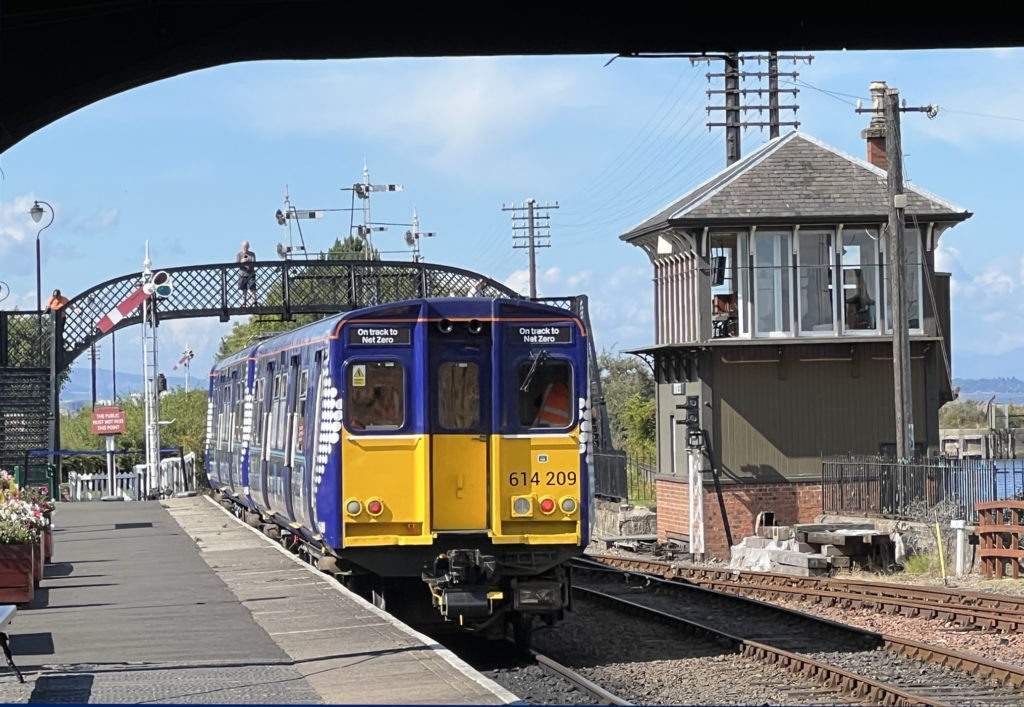
And what of the future of the Class 614 unit? By the end of the year, it will have served its purpose, yet it would be unfortunate if it were scrapped. Perhaps it could still have a role in demonstrating a hydrogen train to the public by offering passenger trips on the Bo’ness railway. Though safety approval of such a service might not be easy, it may help gain public acceptance and awareness of the importance of a new hydrogen economy.
When I rode on the train, I enjoyed the new experience of travelling on a quiet, non-electrified train. Perhaps others could be similarly impressed.

